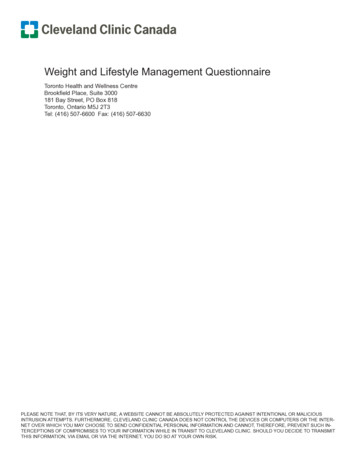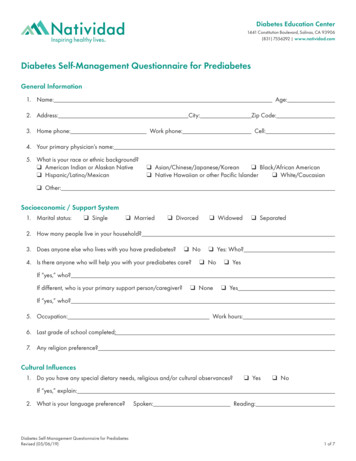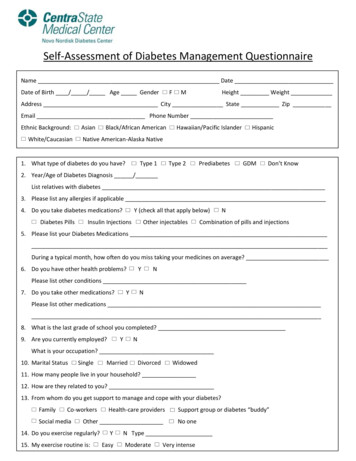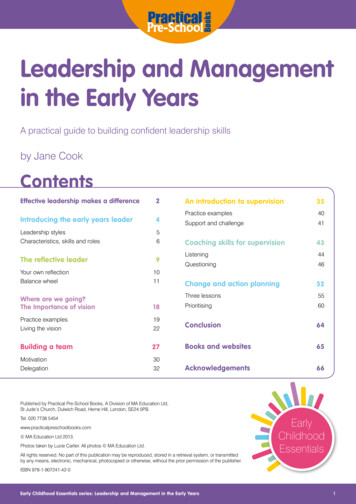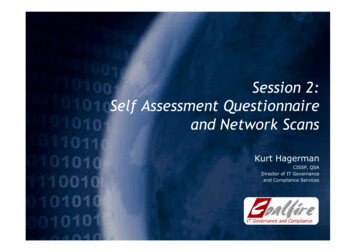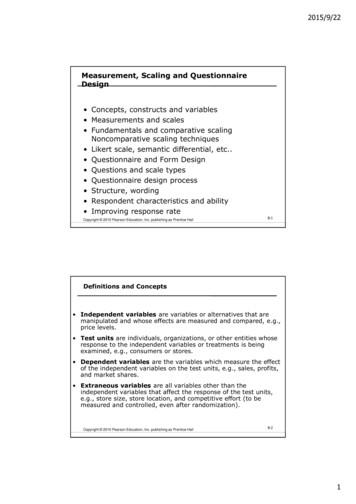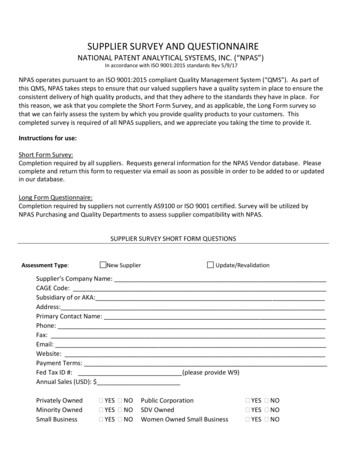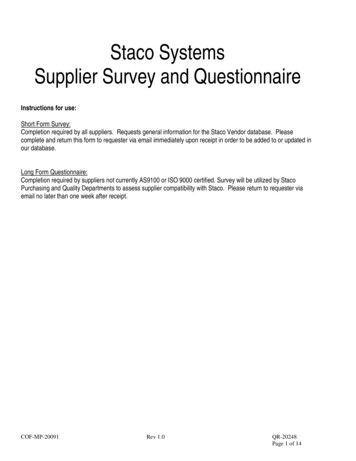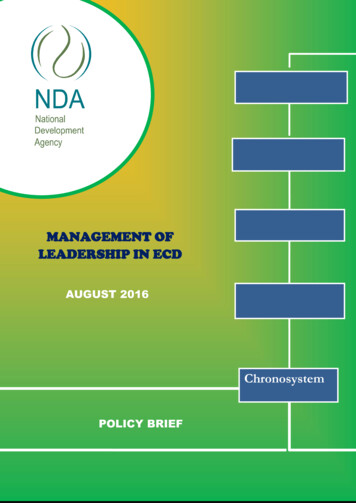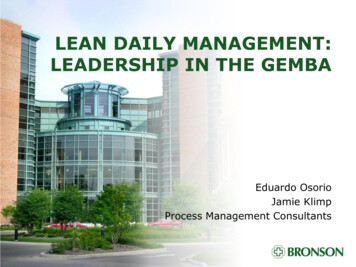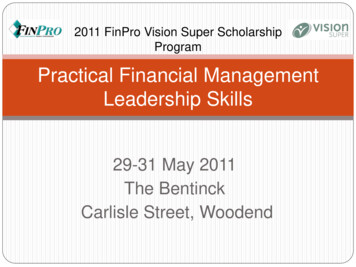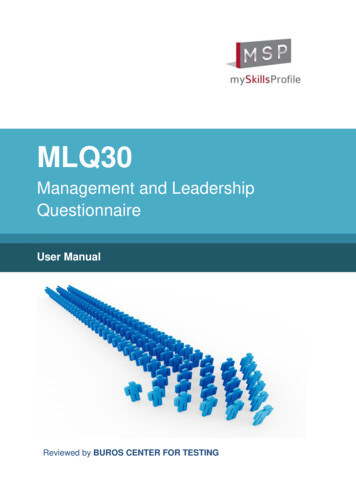
Transcription
MLQ30Management and LeadershipQuestionnaireUser ManualReviewed by BUROS CENTER FOR TESTING
MLQ30Management and LeadershipQuestionnaireUser ManualJohn Beazer and Allan Cameron2015, MySkillsProfile.com Limitedwww.myskillsprofile.com.comMLQ30 is a trademark of MySkillsProfile.com Limited.All rights reserved. No part of this publication may be reproduced or distributedin any form or by any means or stored in a database or retrieval systemwithout the prior written permission of MySkillsProfile.com Limited.
Contents1.Introduction . 11.1 Purpose of MLQ30 questionnaire . 11.2 Versions of questionnaire . 21.3 Development of competency framework . 21.4 Production of assessment test . 61.5 Comparison with other competency frameworks. 81.6 Correlation with job performance . 82.Applications and administration. 122.1 Applications . 12Selection . 12Assessment and development centers. 12Training and development . 12Coaching and counseling . 122.2 Administration . 132.3 Norming . 133.Scale descriptions . 144.Interpretation. 474.1 Sten scores . 474.2 Feedback report . 485.Reliability and validity . 505.1 Internal consistency reliabilities . 505.2 Scale intercorrelations . 505.3 Exploratory factor analysis . 525.4 Relationship with other measures . 565.5 Relationship with job performance . 605.6 Demographics . 646.Norms . 696.1 Characteristics . 696.3 Norms table . 717.References . 73
1 MLQ30 User Manual1. IntroductionThis User Manual gives an overview of the application, administration, interpretation andreliability and validity of the MLQ30 normative questionnaire. Evidence for the reliability andvalidity is presented against some of the key the criteria in the EFPA Review Model for theDescription and Evaluation of Psychological Tests (Bartram, 2002). The EFPA ReviewModel was produced to support and encourage the process of harmonizing the reviewing oftests. It provides a standard set of criteria to assess the quality of tests. These cover thecommon areas of test review such as norms, reliability, and validity.1.1 Purpose of MLQ30 questionnaireThe MLQ30 questionnaire was designed to provide information about an individual’smanagement and leadership competencies and skills. The MLQ30 competency modelmeasures 30 dimensions of management and leadership competence covering 6 key areas(Figure 1). These cover the transformational and transactional aspects of managerial andleadership activity.Figure 1. Key areas of management and ciesStrategic andcreative thinkingImplementingand improvingLeading anddecidingCommunicatingand presentingDeveloping andchangingRelating andsupporting 2015, MySkillsProfile.com
2 MLQ30 User Manual1.2 Versions of questionnaireThere are two versions of the questionnaire. The normative version of the questionnairerequires a test taker to rate their current performance on different competencies on a 5 pointLikert scale ranging from “Emerging” to “Elite”. The normative version has two scalesmeasuring Impression Management and Self-Deception in addition to the 30 scales thatmeasure management and leadership competencies. The questionnaire consists of 192statements (6 items per scale) and most test takers complete the test in less than 30minutes. Table 1a-b below defines what each of the competency scales measure.The ipsative version of the questionnaire presents test takers with blocks of threecompetency statements, and the task is to identify the competency that the test taker does'best', and the competency that the test taker does 'least' well. There are 100 blocks of threeitems, and the majority of people complete the test in less than 30 minutes.1.3 Development of competency frameworkThe first phase in the development of the assessment was a wide-ranging literature reviewduring which we examined theories and models of management and leadership,competency frameworks, self-assessment tests, and 360-degree feedback surveyinstruments.The key purpose of the review was to gather information about management and leadershipcompetencies. We adopted Bartram’s (2002) definition of competencies as “behavioralrepertoires” or “sets of behaviors that are instrumental in the delivery of desired results.”Competencies, according to Bartram, are behaviors that support the attainment oforganizational objectives. In the context of leadership, they describe what it is that people inleadership positions do in order to meet their objectives and how they go about achievingtheir goals and targets. The output from the literature review was a long list of possiblemanagement and leadership competencies recorded on a spreadsheet.In the second phase, our goal was to build a draft management and leadership framework inthe format of a typical competency framework--that is, in a format similar to the Consortiumfor Research on Emotional Intelligence’s Emotional Competence Framework (Consortium forResearch on Emotional Intelligence in Organizations, 1998) or SHL’s UniversalCompetency Framework (Bartram, 2012).These competency frameworks are made up of hierarchical clusters of competencies. Forexample, the SHL Universal Competency Framework is a three-tier framework with 8 keyareas (for example, “Creating and conceptualizing”), 20 competency dimensions (forexample, “Formulating strategies and concepts”), and 112 competency components (forexample, ”Sets and develops strategies”). 2015, MySkillsProfile.com
3 MLQ30 User ManualTable1a. What the MLQ30 leadership scales measureLeadership/Transformational Competencies1Strategic and CreativeThinkingCompetency Requirements1.1Thinking and managinggloballyKeep up to date with global trends, review the company's position,develop business relationships in other countries.1.2Developing strategy andacting strategicallySee the big picture, pick up changes in the marketplace, review andanalyze the business unit's strategy.1.3Managing knowledge andinformationKeep up with advances in business area, benchmark performanceagainst industry leaders, seek advice from experts.1.4Creating and innovatingHelp people to think differently about a problem, get buy-in forcreative ideas, turn novel ideas into reality.1.5Managing costs and financialperformanceRead and interpret financial reports, set financial targets, review andimprove financial performance.2Leading and DecidingCompetency Requirements2.1Attracting and managingtalentHelp new employees get up to speed quickly, give peoplechallenging job assignments, monitor people’s performance.2.2Motivating people andinspiring them to excelCommunicate high expectations of people, trust capable people todo their work, celebrate team achievement.2.3Coaching and developingpeopleProvide people with assignments to develop their skills, give timelycoaching, act as a role model for development.2.4Managing culture anddiversityDefine acceptable workplace behavior, challenge bias andintolerance, act as a role model of inclusive behavior.2.5Making sound decisionsAssess options and risks, consult people and take their views andideas into account, act decisively.3Developing and ChangingCompetency Requirements3.1Displaying initiative and driveStart tasks right away, get things done quickly, be ready to go theextra mile.3.2Showing courage andstrengthDo what is right despite personal risk, say no when necessary, havethe courage to take tough decisions.3.3Learning and developingcontinuouslySeek feedback, set personal development goals, show a sense ofhumor and perspective.3.4Managing and implementingchangeSell the benefits of change, model the change expected of others,establish roles and structures to support change.3.5Adapting and coping withpressureAdapt quickly to new situations, handle stress successfully, keepcomposure in difficult circumstances. 2015, MySkillsProfile.com
4 MLQ30 User ManualTable 1b. What the MLQ management scales measureManagement/Transactional focus4Implementing andImprovingCompetency Requirements4.1Executing strategies andplansProvide direction and support, delegate responsibility to the appropriatepeople, hold people accountable for delivery.4.2Improving processes andsystemsAllocate responsibility for improvement, learn lessons from processbreakdowns, improve business processes.4.3Managing customerrelationships and servicesSet high standards for customer service, exceed customer expectations,resolve customer issues quickly.4.4Analyzing issues andproblemsGather information from a wide variety of sources, approach problemsfrom different angles, brainstorm possible solutions with others.4.5Managing plans and projectsDevelop bold plans, obtain resources to carry out projects, managecritical dependencies and risks.5Communicating andPresentingCompetency Requirements5.1Facilitating and improvingcommunicationCreate a climate where people share views and ideas, exchangeinformation with the team, bosses and stakeholders.5.2Influencing and persuadingpeoplePromote views and ideas, influence people by addressing their needsand priorities, negotiate effectively.5.3Managing feelings andemotionsKnow which emotions you are feeling and why, handle other people’sfeelings and emotions sensitively.5.4Speaking with confidence andpresenting to groupsDemonstrate presence, communicate with self-assurance, give effectivepresentations to groups.5.5Writing and reportingProduce clearly written reports, write effectively for different audiences,edit other people's written work skillfully.6Relating and SupportingCompetency Requirements6.1Relating and networkingWork effectively with other people, build rapport and keep others in theloop, use networks to get things done.6.2Listening and showingunderstandingPut people at ease, pay attention to their feelings and emotions, listenwithout interrupting.6.3Building trust and modelingintegrityAct in accordance with values and principles, give consistent messages,keep promises.6.4Identifying and resolvingconflictEncourage debate, bring disagreements into the open, address andresolve conflict early.6.5Cultivating teamwork andcollaborationSet the team's direction and priorities, review the team's successes andfailures, help team members work well together. 2015, MySkillsProfile.com
Figure 2. MLQ30 management and leadership competency ic andcreative thinkingLeading anddecidingManagementDeveloping andchangingImplementing andimprovingCommunicatingand presentingRelating andsuportingThinking andmanaging globallyAttracting andmanaging talentDisplaying initiativeand driveExecuting strategiesand plansFacilitating andimprovingcommunicationRelating andnetworkingDeveloping strategyand actingstrategicallyMotivating peopleand inspiring them toexcelShowing courage andstrengthImproving processesand systemsInfluencing andpersuading peopleListening andshowingunderstandingManaging knowledgeand informationCoaching anddeveloping peopleLearning anddevelopingcontinuouslyManaging customerrelationships andservicesManaging feelingsand emotionsBuilding trust andmodeling integrityCreating andinnovatingManaging cultureand diversityManaging andimplementingchangeAnalyzing is
challenging job assignments, monitor people’s performance. 2.2 Motivating people and inspiring them to excel Communicate high expectations of people, trust capable people to do their work, celebrate team achievement. 2.3 Coaching and developing people Provide people with assignments to develop their skills, give timely

